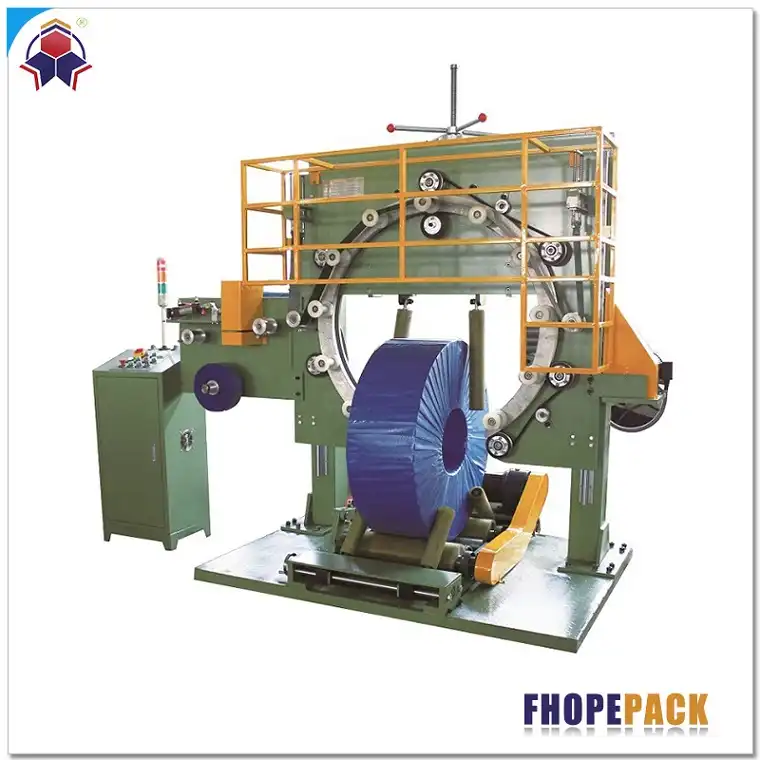“`html
In the world of industrial machinery, a wire coil packing machine stands as an indispensable asset. It’s pivotal in ensuring that wire coils are wrapped and secured effectively, preventing damage during transit. However, the question looms: how does one select the right machine tailored to specific needs? This conundrum can be daunting, given the plethora of options available.
Understanding the nuances of these machines is crucial. From the size of the coils to be packed to the type of material used for wrapping, each detail plays a significant role in the decision-making process. The right choice can streamline operations and enhance efficiency, while the wrong one might lead to operational hiccups and increased costs. Thus, it’s essential to delve into the specifics, ensuring that every aspect aligns with your requirements.
Claim: Selecting the appropriate wire coil packing machine is fundamental to optimizing production efficiency and safeguarding product quality.
What are the key considerations when selecting a wire coil packing machine?
1.1 Understanding the types of wire coil packing machines
The market offers various types of wire coil packing machines, each designed for specific tasks. Some cater to heavy-duty industrial coils, while others are designed for smaller, more delicate wires. It’s imperative to identify the scale of operation and the nature of the wire coils to be packed. For instance, automated machines may be suitable for large-scale operations, whereas manual or semi-automated ones could suffice for smaller batches.
1.2 Analyzing data in wire coil specifications

A closer look at the numbers can provide clarity. Consider the following table that outlines typical specifications:
| Machine Type | Coil Diameter (mm) | Wrapping Speed (m/min) | Weight Capacity (kg) |
|---|---|---|---|
| Automated | 500 – 2000 | 20 – 60 | 1000 |
| Semi-Automated | 300 – 1500 | 10 – 30 | 500 |
| Manual | 100 – 1000 | 5 – 15 | 250 |
1.3 Insights on machine efficiency and cost-effectiveness
While evaluating machines, efficiency and cost-effectiveness should remain at the forefront of consideration. Automated machines, though initially more expensive, can offer better long-term savings by reducing labor costs and increasing throughput. Meanwhile, manual systems might appear cheaper but could incur higher labor costs over time. Each option presents its own set of advantages and challenges, necessitating a careful balance between immediate budget constraints and future savings.
1.4 Delving deeper: Size, speed, and capacity
Beyond the basics, examining additional parameters such as size, speed, and capacity can inform the decision. Here’s a deeper look:
| Factor | Description | Importance |
|---|---|---|
| Size | Larger machines accommodate bigger coils | High for industrial use |
| Speed | Impacts overall productivity rates | Crucial in high-demand settings |
| Capacity | Determines the weight handling ability | Vital for safety and reliability |
1.5 Two-Fact Statement: True or False?
True Fact: Automated machines can significantly reduce labor costs over time due to increased efficiency.
False Fact: Manual machines always result in lower operational costs than their automated counterparts. This assumption fails when labor costs accrue over time, making them potentially more expensive.
How does customization impact your choice of wire coil packing machine?
2.1 The value of customization in wire coil packaging
Customization can play a pivotal role in aligning a wire coil packing machine with unique operational needs. Given the diverse range of wire types and sizes, having a machine tailored to specific requirements can greatly enhance efficiency and productivity. Custom solutions often entail modifications in software, hardware, or both, catering specifically to the operational idiosyncrasies of a business.
2.2 Visualizing the benefits and challenges

Consider the benefits and potential challenges associated with customized machines:
| Aspect | Benefit | Challenge |
|---|---|---|
| Flexibility | Adapts to changing production demands | Higher initial costs |
| Precision | Tailored to exact specifications | Extended lead times for delivery |
2.3 Explaining the customization process
The customization process typically begins with a comprehensive assessment of operational needs and current limitations. This involves collaboration between manufacturers and clients to ensure a seamless integration of technology and functionality. The aim is to develop a solution that not only fits current demands but also offers scalability for future growth. Such collaboration often results in a unique synergy, enhancing the overall efficiency of production processes.
2.4 Conclusion: Key insights and practical takeaways
To summarize, choosing the right wire coil packing machine involves a meticulous evaluation of several factors including automation level, customization, and cost implications. The table below highlights actionable insights:
| Insight | Action |
|---|---|
| Understand your operational scale | Select a machine that matches coil volume and frequency |
| Balance initial cost with long-term savings | Consider total cost of ownership, not just purchase price |
| Assess customization needs | Engage with manufacturers for tailored solutions |
Conclusion
In conclusion, the journey to selecting the right wire coil packing machine requires careful analysis and understanding of specific operational needs. By weighing factors such as machine type, customization potential, and long-term costs, businesses can make informed decisions that enhance efficiency and productivity. Ensuring the chosen machine aligns with current and future demands is paramount for sustained success.
Final Claim: The strategic selection of a wire coil packing machine serves as a cornerstone for operational excellence and competitive advantage.
“`

